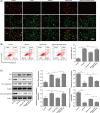Astragaloside alleviates alcoholic fatty liver disease by suppressing oxidative stress
- PMID: 33973356
- PMCID: PMC11896517
- DOI: 10.1002/kjm2.12390
Astragaloside alleviates alcoholic fatty liver disease by suppressing oxidative stress
Abstract
Alcoholic fatty liver disease (AFLD) is the most common liver disease and can progress to fatal liver cirrhosis and carcinoma, affecting millions of patients worldwide. The functions of astragaloside on the cardiovascular system have been elucidated. However, its role in AFLD is unclear. Ethanol-treated AML-12 cells were used as a cell model of alcoholic fatty liver. Real-time quantitative reverse transcription-PCR and Western blotting detected genes and proteins expressions. Reactive oxygen species (ROS), triglyceride, total cholesterol, low-density lipoprotein, albumin, ferritin, bilirubin, superoxide dismutase, aspartate aminotransferase (AST), and alanine aminotransferase (ALT) were examined using commercial kits. Lipid accumulation was assessed by Oil red O staining. MTT and flow cytometry measured cell viability and apoptosis. JC-1 was used to analyze mitochondrial membrane potential. A rat model of AFLD was established by treating rats with ethanol. Astragaloside suppressed ethanol-induced lipid accumulation, oxidative stress, and the production of AST and ALT in AML-12 cells. Ethanol induced TNF-α and reduced IL-10 expression, which were reversed by astragaloside. Ethanol promoted Bax expression and cytochrome C release and inhibited Bcl-2 and ATP expression. Astragaloside hampered these apoptosis effects in AML-12 cells. Impaired mitochondrial membrane potential was recovered by astragaloside. However, all these astragaloside-mediated beneficial effects were abolished by the ROS inducer pyocyanin. Ethanol-induced activation of NF-κB signaling was suppressed by astragaloside in vitro and in vivo, suggesting that astragaloside inhibited oxidative stress by suppressing the activation of NF-κB signaling, thus improving liver function and alleviating AFLD in rats. Our study elucidates the pharmacological mechanism of astragaloside and provides potential therapeutic strategies for AFLD.
Keywords: alcoholic fatty liver disease; astragaloside; lipid accumulation; oxidative stress.
© 2021 The Authors. The Kaohsiung Journal of Medical Sciences published by John Wiley & Sons Australia on behalf of Kaohsiung Medical University.
Conflict of interest statement
The authors declare that there are no conflicts of interest.
Figures






Similar articles
-
Protective effects of E Se tea extracts against alcoholic fatty liver disease induced by high fat/alcohol diet: In vivo biological evaluation and molecular docking study.Phytomedicine. 2022 Jul;101:154113. doi: 10.1016/j.phymed.2022.154113. Epub 2022 Apr 25. Phytomedicine. 2022. PMID: 35490493
-
Astragaloside IV Alleviates Liver Inflammation, Oxidative Stress and Apoptosis to Protect Against Experimental Non-Alcoholic Fatty Liver Disease.Diabetes Metab Syndr Obes. 2021 Apr 28;14:1871-1883. doi: 10.2147/DMSO.S304817. eCollection 2021. Diabetes Metab Syndr Obes. 2021. PMID: 33953586 Free PMC article.
-
Aqueous Extract of Pepino (Solanum muriactum Ait) Leaves Ameliorate Lipid Accumulation and Oxidative Stress in Alcoholic Fatty Liver Disease.Nutrients. 2018 Jul 20;10(7):931. doi: 10.3390/nu10070931. Nutrients. 2018. PMID: 30037014 Free PMC article.
-
The Role of Oxidative Stress in Alcoholic Fatty Liver Disease: A Systematic Review and Meta-Analysis of Preclinical Studies.Nutrients. 2024 Apr 15;16(8):1174. doi: 10.3390/nu16081174. Nutrients. 2024. PMID: 38674865 Free PMC article.
-
n-3 Polyunsaturated fatty acids for the management of alcoholic liver disease: A critical review.Crit Rev Food Sci Nutr. 2019;59(sup1):S116-S129. doi: 10.1080/10408398.2018.1544542. Epub 2018 Dec 22. Crit Rev Food Sci Nutr. 2019. PMID: 30580553 Review.
Cited by
-
Protective effect of traditional Chinese medicine on non-alcoholic fatty liver disease and liver cancer by targeting ferroptosis.Front Nutr. 2022 Oct 18;9:1033129. doi: 10.3389/fnut.2022.1033129. eCollection 2022. Front Nutr. 2022. PMID: 36330148 Free PMC article. Review.
-
Establishment and bioinformatics evaluation of the ethanol combined with palmitic acid-induced mouse hepatocyte AFLD model (the Hu-Qiu Model).Heliyon. 2023 Aug 22;9(9):e19359. doi: 10.1016/j.heliyon.2023.e19359. eCollection 2023 Sep. Heliyon. 2023. PMID: 37681138 Free PMC article.
-
Phytochemicals Targeting Inflammatory Pathways in Alcohol-Induced Liver Disease: A Mechanistic Review.Pharmaceuticals (Basel). 2025 May 11;18(5):710. doi: 10.3390/ph18050710. Pharmaceuticals (Basel). 2025. PMID: 40430529 Free PMC article. Review.
-
Vitamin C injection improves antioxidant stress capacity through regulating blood metabolism in post-transit yak.Sci Rep. 2023 Jun 23;13(1):10233. doi: 10.1038/s41598-023-36779-w. Sci Rep. 2023. PMID: 37353533 Free PMC article.
-
Effects of Astragaloside IV and Formononetin on Oxidative Stress and Mitochondrial Biogenesis in Hepatocytes.Int J Mol Sci. 2025 Jan 17;26(2):774. doi: 10.3390/ijms26020774. Int J Mol Sci. 2025. PMID: 39859490 Free PMC article.
References
-
- Rakha EA, Adamson L, Bell E, Neal K, Ryder SD, Kaye PV, et al. Portal inflammation is associated with advanced histological changes in alcoholic and non‐alcoholic fatty liver disease. J Clin Pathol. 2010;63(9):790–5. - PubMed
-
- Cederbaum AI, Lu Y, Wu D. Role of oxidative stress in alcohol‐induced liver injury. Arch Toxicol. 2009;83(6):519–48. - PubMed
MeSH terms
Substances
LinkOut - more resources
Full Text Sources
Other Literature Sources
Medical
Research Materials

